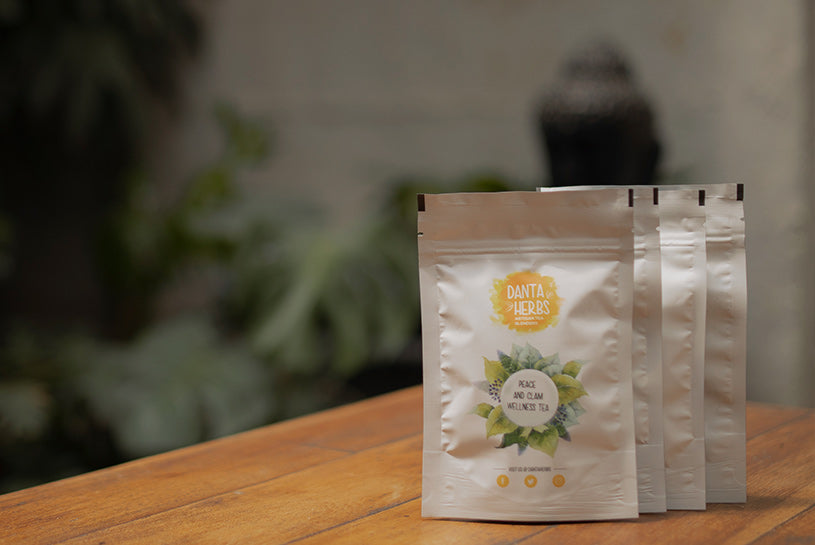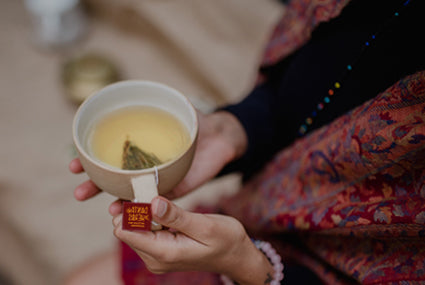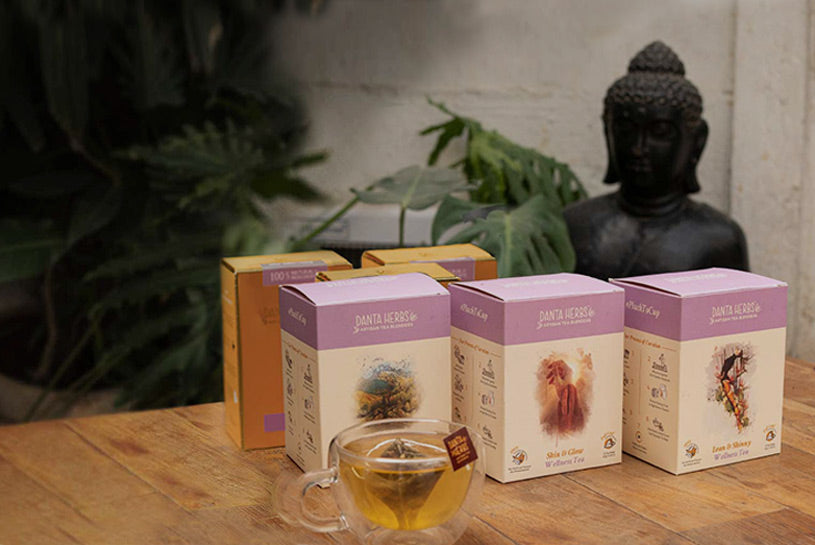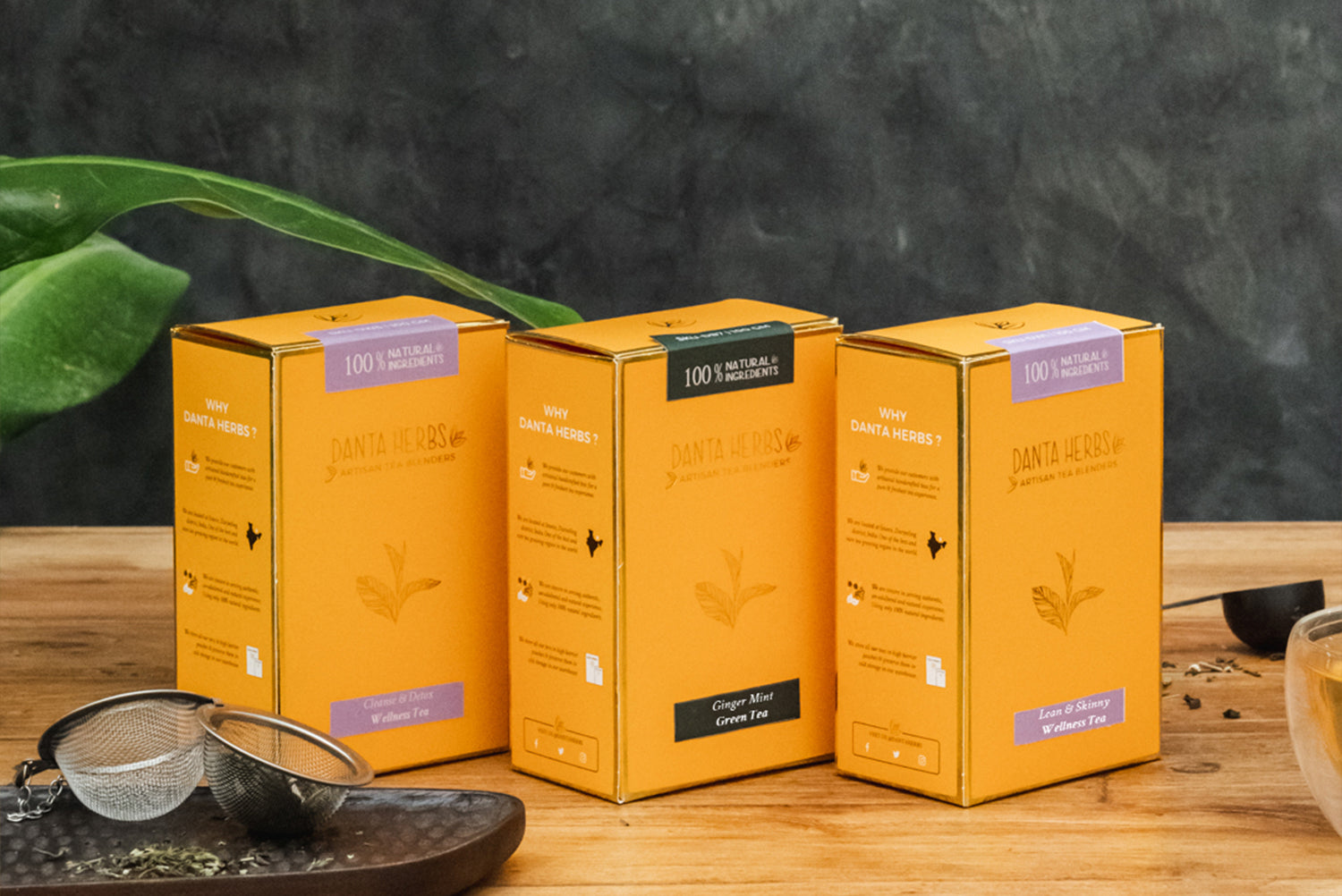A detailed Guide on selection of Tea: Danta Herbs

SELECTION OF TEAS
By Type of Tea
Black tea
Black Tea is highly oxidised and therefore is dark in colour. All the steps like withering, rolling, fermentation and firing are involved in the production of black tea. Loose leaf teas can be made in an orthodox way or by using CTC (crush, tear, curl), mechanized technique. It is full bodied and has a malty aroma and is astringent in taste.When brewed the tea colour varies from amber to red to dark brown.
Oolong Tea
Oolong Tea is semi oxidised. This oxidation is the uniqueness of Oolong tea. It is in between black tea and green tea. The leaves are either curled long or wrapped curled into pearl like forms. It is full bodied and has grassy aroma with a sweet to toasty taste. When brewed the tea colour varies from amber to red.
Chai
Chai is prepared with spices such as ginger, cinnamon, peppercorns, cardamom, nutmeg, depending on the region. It is one of the most popularly harvested tea varieties in India, each region has a distinct variety to offer. It is full bodied with a sweet to spicy aroma and sweet to sharp taste.
When steeped the tea colour varies from amber to red to dark brown. (Without milk)
White tea
White is least oxidised which results in fresh-from-garden taste in the tea. The colour is also very close to harvested tea. White tea is set apart by the silvery-white fuzz that covers the unopened buds. It is processed in two variations, one where the leaves are withered for a long time before they are dried, and another where the leaves are first steamed or fired in order to deactivate polyphenol oxidase, and then dried. It is mild bodied with a fruity aroma and delicate taste. When brewed the tea colour varies from champagne to light yellow.
Green tea
It is very mild in flavour and is lightly oxidised. It is packed with antioxidants and is mildly processed. It is medium bodied with earthy aroma and vegetal taste. When brewed the tea colour varies from amber to orange.
Blends/tisanes
Tisanes and blends are medicinal and herbal blends that are made with tea. It adds to the nutritional benefits of the raw ingredients used in the blend. The raw ingredients used are flowers, spices and herbs. The aroma, flavour and even colour would differ owing to the raw ingredients used.
By Seasons of Tea
Tea flush is the perfect time to pick the tea leaves. The flush determines the quality of the tea leaves. Many factors influence the tea taste, such as weather, sun, rain, soil (terroir). The tea flush is the period of picking tea leaves that differentiates one from another.
First Flush or Spring Flush
First flush arrives in early to late spring, in the months of February and March. This is when the tea plants have rested during the period of winter and the days start to become longer and warmer. Tea is best when they experience sunlight and warmth. Much like its growth, first flush tea tastes like warm sunlight- bright, light and fresh. Tea connoisseurs greatly value first flush and are willing to pay premium prices for first flush.
In-between flush
This flush is between the first flush (post March) and before the second flush (before June).
Second Flush or Summer Flush
This flush occurs in the peak of the summer heat in India- June. It is marked by vigorous growth in the tea plant. The spurts of rain experienced at this time bring the much needed nourishment to the tea plant. The tea is darker than the first flush and the tea is not robust owing to excessive water absorption.
Third flush or Monsoon flush
This flush period post the Indian monsoon. The tea leaves are mature which gives the tea its strong body. The growth of the tea stops as the rains stop and the terroir is the strongest during this stage. The tea when brewed, is amber in colour.
Autumn Flush
This flush is the last season of picking tea in the year, and takes place in late October- early November time. The teas from this flush are intensely aromatic, rich bodied and a mouthful with floral notes.
Winter Flush
This flush is exclusively in the Nilgiri region owing to its climatic conditions. They are picked from December to January. The plant doesn’t receive much sunlight or water. The teas from this season are light-bodied, highly aromatic with fruity notes.
By Region
In determining the quality of tea it is quintessential to know the region where tea was cultivated. As soil, climate, and season are factors that influence the tea. While regions may grow several types of teas, however each region is popular for a kind of tea that becomes their speciality.
Historically, tea growing regions in India were discovered by the British East India Company. Since China was the sole tea growing nation one could procure tea only from there. But owing to the high taxes levied for importing tea Britain decided to grow tea from some seeds that were brought (some may say stolen) from China. India being a British Colony was made subject to this exploration and surprisingly several parts of India were found extremely suitable for tea cultivation.
Darjeeling
Darjeeling is the most popular region of tea cultivation in the world. Located in the eastern part of India, this region produces the much revered tea also known as Champagne of Tea. This is the region that can be attributed to make Indian teas popular worldwide.
This region produces black, green, oolong and white teas. Since, this region is an old tea hub. The techniques are orthodox to maintain the quality of tea associated with the craft of tea cultivation here. The characteristic features of the teas here are mild bodied, bright colours and strong astringency. Some of the famous tea estates from the region are Jungpana, Goomtee, Makaibari, Singtom, and Gopaldhara. The teas grown in this region consistently receive awards in auctions.
Assam
Assam is in close one of the most biodiversity rich regions with close to 507 million kg production of tea, making it the world’s largest tea growing region. Assam is known for producing both orthodox and CTC varieties of tea. The teas produced here are simply called Assam Tea. However, only the teas grown in the estates from Brahmaputra Valley are qualified to be called Assam teas.
The teas from here can be characterised as brisk, strong, malty flavoured. The popular English Breakfast Tea is made using tea belonging to this region. The popular tea estates from this region are Koilamari, Gingia, Manjulighur, among a few others.
Nilgiris
This blue mountain range is located in the southern region of India and is the part of the vast Western Ghats. Its most famous attribute is the flower Kurinji (blue in colour) that grows here. Hence it is called Nilgiri (blue mountains). It is equally popular for it’s tea. The tea found in this region are black, ctc, green, oolong and white. Most popular are whole leaf grade Orange Pekoe and Pekoe cut black tea. Some of the popular tea estates are Craigmore, Chamraj, Unitea, and Glendale.
North East
The North East region of India experiences high rainfall throughout the year, especially in Meghalaya. Initially, owing to the split of the state of Assam and creation of Meghalaya, the Khasi ruler forbade labour to enter therefore, not entertaining the tea market. Later, in the 70s owing to the popularity of Darjeeling and Assam tea Meghalaya was again looked at as an opportune place for tea cultivation. The regions of Umsning in Ri–Bhoi district, Tebronggre in West Garo Hills and Riangdo in the West Khasi Hills is where the cultivation first began. LaKyrsiew is a famous tea estate in the region. Mizoram recently began cultivating tea. F.Kapsanga, Ngopa and Kanan, Aizwal in Mizoram, Nilai and Jiribam In Manipur are few popular tea estates in the region.
Kangra
Kangra is located in the northern part of India, the state of Himachal Pradesh. It is known as the “valley of gods'' and is famous for its distinct flavoured tea. This region has been growing tea as early as 1949. In 1849, Dr. Jameson conducted a feasibility survey of the valley of Kangra and concluded it suitable for tea cultivation. He brought Chinese tea plants from the nurseries at Almora and Dehradun and planted them in Government gardens at Kangra and Bhawama. The region grows both black and green tea varieties, Pekoe, Pekoe Suchong, Coarse teas and Fannings in black while Hyson, Young Hyson and Coarse grades are popular ones in green tea.
Nepal
The country of Nepal was introduced to tea cultivation much later and is relatively a young tea growing country, and it’s believed that the first tea bushes were a gift to Nepal’s Prime Minister Jung Bahadur Rana by a Chinese Emperor. Another story is that in 1863, Colonel Gajraj Singh Thapa, son-in-law of Jung Bahadur Rana visited Darjeeling and tasted the tea. Apparently, he loved it so much that he decided to set up estates in his country – and that’s how the first tea gardens of Nepal were born – the first at Ilam and two years later, in Soktim. While the tea estates in Ilam were used to grow orthodox tea, Soktim’s gardens produced CTC tea and 90% of all tea consumed in Nepal is CTC tea.
We at Danta Herbs bring you freshest leaves for your magical brew from the tea estates in Darjeeling, Nilgiris, Assam, Kangra, North east and Nepal.
FAQ’s:
- What are the 3 types of tea?
From just one plant, there are over 1500 different varieties of teas that are categorized into three groups: black, green and oolong. Teas are grouped based on how much processing they go through and the amount of time they are in contact with oxygen.
2. In which season tea is grown?
Here the planters harvest the tea leaves from March to Mid-November. Though there are four flushes or seasons for Assam tea, you will get the better quality tea on the first two flushes. The first flush or the spring flush starts in late March. The second flush occurs during the end of May to June.
What are the 3 types of tea?
From just one plant, there are over 1500 different varieties of teas that are categorized into three groups: black, green and oolong. Teas are grouped based on how much processing they go through and the amount of time they are in contact with oxygen.
In which season tea is grown?
Here the planters harvest the tea leaves from March to Mid-November. Though there are four flushes or seasons for Assam tea, you will get the better quality tea on the first two flushes. The first flush or the spring flush starts in late March. The second flush occurs during the end of May to June.




